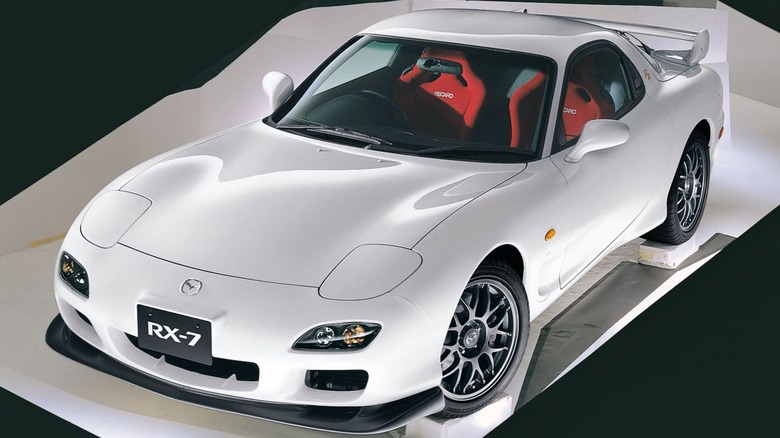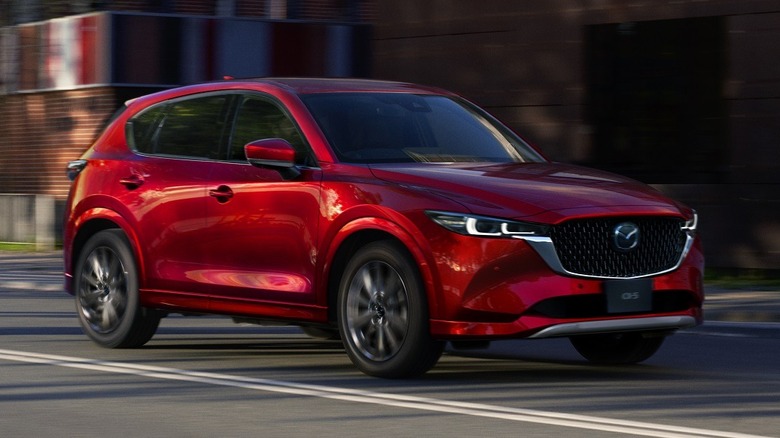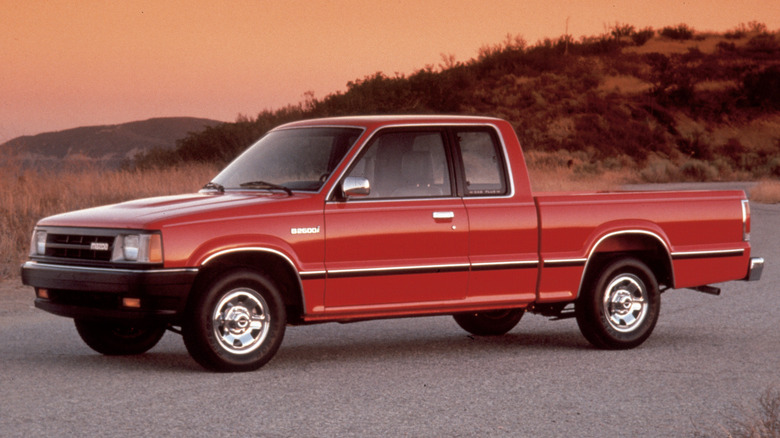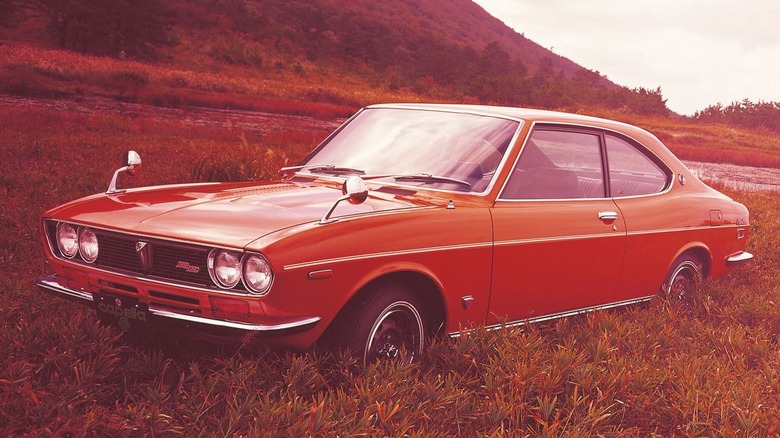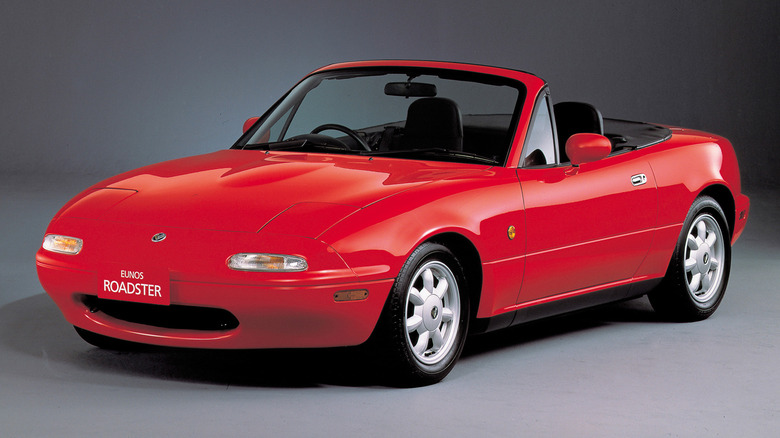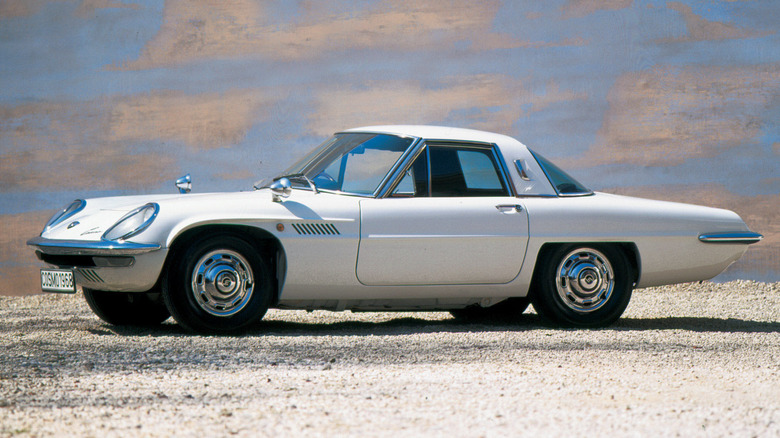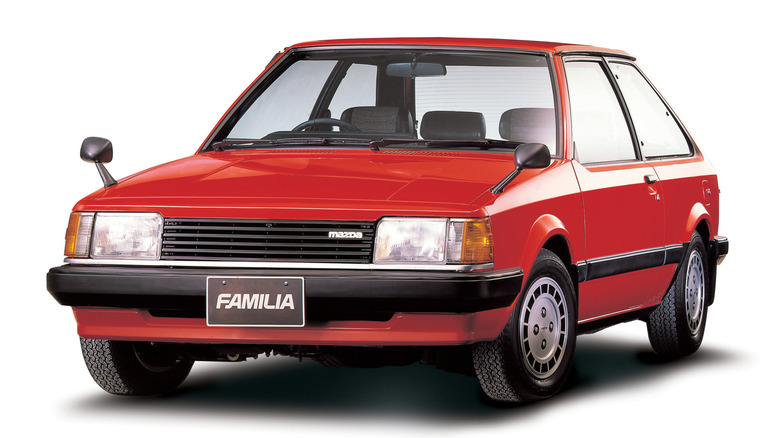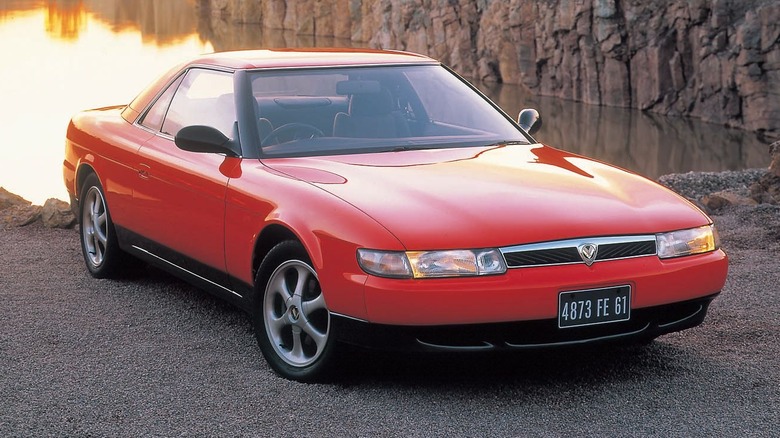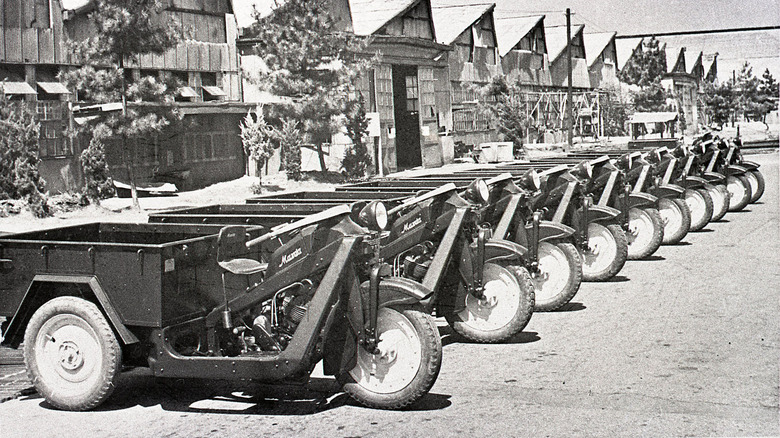10 Of The Most Successful Models In Mazda History
The first products made by what is now called Mazda Motor Corporation weren't cars but corks. Originally founded as Toyo Cork Kogyo Company in 1920, Mazda decided to branch out into making three-wheeled trucks in the 1930s. This isn't all that unusual for a Japanese manufacturer; for example, Yamaha started out making musical instruments before developing its own motorcycle division, and Subaru originally built aircraft before it launched its first car, the 360, in the late '50s. Around the same time, Mazda was also busy developing its first passenger car, which launched in 1960 as the R360.
The R360 quickly established Mazda as a serious player in the automotive industry, accounting for 15% of all new car sales in Japan during its first year on sale. Mazda built on that momentum, launching a range of models for varying customers. Fast forward to the present day, and Mazda is still continuously adapting its lineup to suit buyers' tastes, and has built up a long list of highly successful models as a result. These 10 models are among the brand's most successful to date.
Mazda RX-7 (1978-2002)
One of Mazda's most iconic nameplates, the RX-7, nearly didn't have a rotary engine. When Mazda bosses were toying with making a sports car in the '70s, the oil crisis was in full swing, and buyers were turning away from fuel-hungry cars. The rotary engine was known to be less efficient than its traditional rivals, but still Mazda refused to give up on it.
The brand developed a new, more reliable and less gas-guzzling version of the engine, and fitted it under the hood of its newest sports car, the FB RX-7. It was launched in Japan in 1978, with 133 horsepower on offer and a curb weight of around 2,200 pounds. Over the following years, the car was also launched in Europe and the U.S., where it could be had with a 13B rotary under the hood.
The FC RX-7 launched in 1985 and offered more power and Euro-inspired styling, but the generation that most enthusiasts remember today is the FD RX-7 that launched in 1992. Its unique looks and powerful rotary engine made it unlike any other car on sale, and thanks to the distinctive exhaust note of said engine, it sounded unlike anything else to boot. It was discontinued from most export markets in the '90s but remained on sale in Japan until 2002, when it was replaced by the RX-8. Over its production run, over 800,000 examples of the RX-7 were built, making it the most commercially successful rotary car ever.
Mazda Mazda3 (2003-Present)
While it might not boast the same performance chops as Mazda's best sports cars, the Mazda3 has carved out a reputation over its time on sale for being a cut above other affordable cars when it comes to driving dynamics. It was first unveiled in 2003, and launched in America for the 2004 model year. In 2016, Mazda announced that the car had sold five million units globally, becoming the fastest car in Mazda's history to do so. At the time, the brand noted that one in every three cars it sold each year was a Mazda3.
The first generation Mazda3 was designed to replace the Mazda Familia, which was known in export markets as the 323 or Protégé. In 2008, Mazda unveiled a second generation of the car, built on the same platform as the original but with revised styling, tech, and powertrains. A third generation arrived in 2013 with further upgrades, while the current, fourth generation of the car debuted at the Los Angeles Motor Show in 2018. The car remains worth buying in both new and used form in 2025, with used examples available for bargain prices even if you're picky about mileage and condition.
Mazda CX-5 (2012-Present)
Modern buyers gravitate towards the practicality and higher ride height of SUVs, and that's helped the CX-5 earn the title of Mazda's best-selling model, with well over three million examples sold since its launch. In the U.S. alone, Mazda sold over 120,000 examples of the CX-5 in 2024. The first generation car launched in 2012 and took styling cues from the Minagi concept car, which Mazda claimed was designed to look like a cheetah pouncing on its prey. The production version looked a lot less dramatic, but it was still one of the better looking SUVs of its era.
The lifespan of the first generation was relatively short, with a second generation launching in 2016. It built on the looks of its predecessor, offering styling that was sharper and closer to the original concept. Buyers have continued to purchase the CX-5 in droves, despite the second generation car now having been on sale for almost a decade. However, a facelift in 2022 has kept the car looking fresh, even if its underpinnings are older than many of its rivals.
Mazda B-Series (1961-2009)
The launch of the B360 in 1961 marked the start of Mazda's long run of B-Series pickup trucks, which would run until the late '00s. The B-Series took a number of different forms around the globe, as Mazda adapted the truck to suit local markets. In 2006, the global B-Series line was succeeded by the BT-50, which remains in production today. In America, the last generation of the B-Series was a rebadged version of the Ford Ranger, with the nameplate surviving until 2009.
Other markets that produced their own version of the B-Series included New Zealand, Iran, and Colombia, among others. In America, the first imported B-Series pickups arrived in the '70s, just as the oil crisis was forcing buyers to rethink their preference for huge, gas-guzzling trucks. During the decade, Mazda briefly offered the B-Series truck with a rotary engine, calling it the Mazda Rotary Engined Pickup or REPU. It proved unpopular with buyers, and today it's gone down as one of the rarest Mazdas ever made.
Its traditional engine siblings were much more popular, although they were hampered in America thanks to the Chicken Tax. In 1994, Ford struck a deal with Mazda to produce American B-Series trucks on the platform of the Ranger, although Mazda's own version of the truck would soldier on for over a decade in other global markets.
Mazda Capella (1970-2002)
The Capella name might not be that familiar to some Mazda enthusiasts outside of Japan, since the car was sold under several other names during its decades-long production run. The original Capella launched in 1970, and put Mazda's pioneering rotary engine into a sporty but attainably expensive car. The rotary version will be better known to many enthusiasts as the RX-2, but a traditional reciprocating engine was also offered. Following generations of the car grew in size with the intention of appealing to a wider range of global markets. Outside of Japan, the car was sometimes sold as the 626.
The fourth generation car was launched in 1982, and made the switch from rear-wheel drive to front-wheel drive. It was the most successful generation of the car yet, being particularly popular in Europe and at home in Japan. At the peak of its popularity, Mazda was churning out 300,000 examples of the car annually. It remained popular into the following decade, when it became better known as the 626. Eventually, the 626 name was phased out alongside the Capella, with the car's eventual replacement sold globally as the Mazda6.
Mazda MX-5 Miata (1989-Present)
Only 11 years after its 1989 launch, Guinness World Records certified the Mazda MX-5 Miata as the best-selling two-seater sports car in history. Its simple rear-drive, front-engine layout and light curb weight captivated buyers, and its affordable price sealed the deal. Throughout its production run, the Miata's power output has remained modest, with the original generation launching with a 116 horsepower engine. That figure was boosted to 128 horsepower in 1994, then 133 horsepower for 1996. The second generation Miata arrived for the 1999 model year, with another modest power increase to 140 horsepower.
The brand continued to boost power output incrementally over the second and third generations, with the latter launched for 2006. The current, fourth generation Miata launched for 2016, and it's proved a favorite both with buyers and reviewers, including here at SlashGear. In our 2025 Miata review, we gave the car a 9/10 rating, calling it "a blast of common sense" compared to the many heavy, electrified performance models that have cropped up in manufacturers' lineups of late.
Mazda Cosmo Sport 110S (1967-1972)
It's one of the shortest lived models here, but the impact that the Cosmo Sport 110S had on Mazda's history shouldn't be understated. It was not only the brand's first rotary engined car but also the first mass-produced dual-rotor sports car on the market, and it proved that there was still potential to be unlocked with rotary engine technology. Dissuaded by issues with reliability, most other manufacturers had abandoned their rotary development programs, which meant that the Cosmo Sport 110S had the market all to itself when it debuted in 1967.
Mazda ensured that reliability wouldn't be an issue by subjecting the car to vast amounts of testing before the first example was delivered to customers. The prototypes were reportedly put through 435,000 miles of testing, both to refine their handling and prove their endurance. The car remained in production until 1972, by which time a new generation of rotary-powered sports car was in development. That car was also called the Cosmo, but it's considered a separate model to the original Cosmo Sport 110S.
Mazda Familia (1963-2003)
Called the Familia in Japan and sold under a variety of names in other markets, Mazda's long-running family car first appeared in 1963, just three years after the brand launched its first passenger car. The initial JDM model was called the Familia Van, and it was pitched at families looking for a larger vehicle with plenty of cargo space. Despite its name, its appearance was closer to a station wagon than a typical van. A Familia Sedan was launched in Japan the following year.
Over the decades, Mazda consistently adapted the Familia to accommodate changing buyer tastes. It was given a thorough styling overhaul in 1967, then offered with a rotary engine for the first time in 1968. The third and fourth generations arrived during the '70s, with Mazda focusing on efficiency for both as a result of the oil crisis. By 1980, the fifth-generation Familia had launched as a front-wheel drive, front-engined car that could be optioned either as a hatchback or as a sedan. Outside of Japan, it was sold as the 323.
It was this generation that cemented the car's legacy outside of Japan, with Mazda selling over a million examples of the fifth-generation Familia/323 in just 27 months. At the time, that made it the fastest car to hit the million sales milestone in history. Production continued over the following two decades, with lifetime Familia/323 sales totalling 10 million by the mid-'90s. In 2003, Mazda replaced the ninth-generation Familia.
Mazda Cosmo (1975-1996)
Not to be confused with the groundbreaking Cosmo Sport of the late '60s, the Cosmo was a separate model that ran for around three decades between the mid-'70s and mid-'90s. Unlike some of the other models here, Mazda didn't get the formula entirely right the first time around. The original generation of the Cosmo — also called the RX-5 if it was equipped with a rotary under the hood — wasn't very popular. Still, it impressed critics, and won the Car of the Year award from Motor Fan Magazine in 1976.
The second generation Cosmo offered significantly revised styling when it debuted in 1981. That made it one of the most aerodynamically efficient cars in the world at the time, with a drag coefficient of 0.32. It's the third generation of the Cosmo that really anchored the nameplate's place in Mazda's history, although it wasn't actually sold under the Mazda brand. As part of its expansion plans in the '80s, Mazda had launched several new sub-brands, including Eunos. The Cosmo was sold under this brand as a Japan-only model, and boasted several production firsts.
It was the first production car to receive a triple-rotor engine, and the most powerful car built in Japan at the time, with an output of around 276 horsepower. It also featured the world's first in-car navigation system. Its high price kept it a low seller, and today it would be shocking to see one on the road outside of Japan.
Mazda-Go (1931-1959)
Three decades before it unveiled its first passenger car, Mazda's first leap into the world of mass-produced vehicles was the Mazda-Go of 1931. The company had built a small batch of motorcycles the year before, but decided to pivot towards making its Mazda-Go three-wheeler after early demand from buyers. The truck spawned a series of related models, including the Type-KC and Type-DC, which drew national attention when a group of them completed a 1,680-mile trek across Japan as part of a promotional stunt.
The Mazda-Go was a basic vehicle, with a single-cylinder engine and handlebar steering. It was designed as a three-wheeler as three-wheeled vehicles were cheaper to tax in Japan at the time. It's not clear exactly when Mazda stopped using the Mazda-Go name, but it continued to build three-wheeled vehicles after the Second World War, alongside four-wheeled trucks like the Type-CA. In 1959, an all-new three-wheeled truck called the K360 with an enclosed cabin and larger engine would replace the original design. This successor also sold well, with Mazda shifting over 300,000 examples in Japan before discontinuing the model at the end of the '60s.

